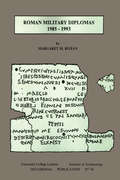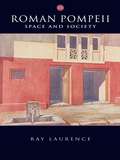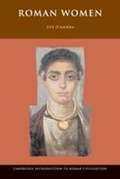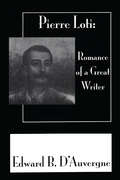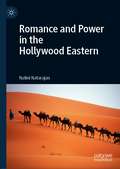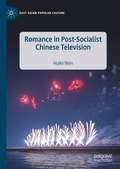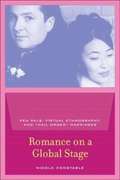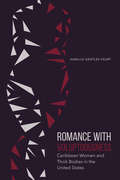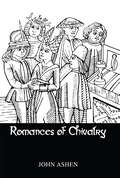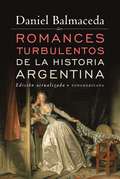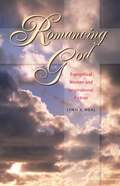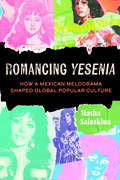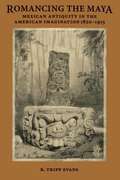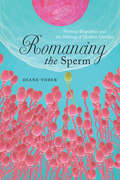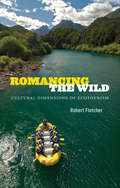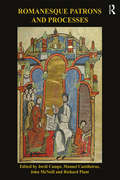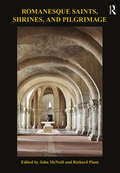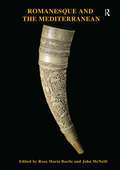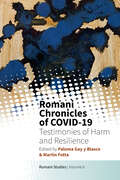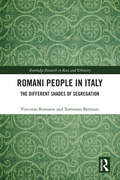- Table View
- List View
Roman Military Diplomas 1985 to 1993 (UCL Institute of Archaeology Publications)
by Margaret M RoxanThis volume publishes records 66 diplomas or fragments which provide vital evidence for the Roman military and legal world. It is the third volume of a set of four created by Roxan.
Roman Phrygia
by Peter ThonemannThe bleak steppe and rolling highlands of inner Anatolia were one of the most remote and underdeveloped parts of the Roman empire. Still today, for most historians of the Roman world, ancient Phrygia largely remains terra incognita. Yet thanks to a startling abundance of Greek and Latin inscriptions on stone, the cultural history of the villages and small towns of Roman Phrygia is known to us in vivid and unexpected detail. Few parts of the Mediterranean world offer so rich a body of evidence for rural society in the Roman Imperial and late antique periods, and for the flourishing of ancient Christianity within this landscape. The eleven essays in this book offer new perspectives on the remarkable culture, lifestyles, art and institutions of the Anatolian uplands in antiquity.
Roman Pompeii: Space and Society
by Ray LaurenceIn this fully revised and updated edition of Roman Pompeii, Dr. Laurence looks at the latest archaeological and literary evidence relating to the city of Pompeii from the viewpoint of architect, geographer and social scientist. Enhancing our general understanding of the Roman world, this new edition includes new chapters that reveal how the young learnt the culture of the city and to investigate the role of property development and real estate in Pompeii’s growth. Showing how Pompeii has undergone considerable urban development, Dr. Laurence emphasizes the relationship between the fabric of the city and the society that produced it. Local activities are located in both time and space and Pompeii’s cultural identity is defined. This book is invaluable for students and scholars in the fields of archaeology and ancient history, as well as being rewarding reading for the many people who visit Pompeii.
Roman Slavery and Roman Material Culture
by Michele GeorgeReplete now with its own scholarly traditions and controversies, Roman slavery as a field of study is no longer limited to the economic sphere, but is recognized as a fundamental social institution with multiple implications for Roman society and culture. The essays in this collection explore how material culture - namely, art, architecture, and inscriptions - can illustrate Roman attitudes towards the institution of slavery and towards slaves themselves in ways that significantly augment conventional textual accounts.Providing the first interdisciplinary approach to the study of Roman slavery, the volume brings together diverse specialists in history, art history, and archaeology. The contributors engage with questions concerning the slave trade, manumission, slave education, containment and movement, and the use of slaves in the Roman army.
Roman Women
by Eve D'AmbraThis richly illustrated book examines the daily lives of Roman women by focusing on the mundane and less-celebrated aspects of daily life -- family and household, work and leisure, worship and social obligations -- of women of different social ranks. <p><p>Using a variety of sources, including literary texts, letters, inscriptions, coins, tableware, furniture, and the fine arts, from the late republic to the high imperial period, Eve D'Ambra shows how these sources serve as objects of social analysis, rather than simply as documents that re-create how life was lived. <p><p>She also demonstrates how texts and material objects take part in shaping realities and what they can tell us about the texture of lives and social attitudes, if not the emotions of women in Roman antiquity.
Roman-Period and Byzantine Nazareth and its Hinterland (The Palestine Exploration Fund Annual)
by Ken DarkRoman-Period and Byzantine Nazareth and its Hinterland presents a new social and economic interpretation of Roman-period and Byzantine Nazareth and its hinterland as a whole, showing the transformation of a Roman-period Jewish village into a major Byzantine Christian pilgrimage centre. Although Nazareth is one of the most famous places in the world, this is the first book on Roman-period and Byzantine Nazareth by a professional archaeologist, the only book to consider the archaeology of Nazareth in the context of its adjacent landscape, and the first to use contemporary archaeological methods and theory to explore Nazareth’s archaeology. Taking as his starting point a systematic survey of the valley between Nazareth and the Roman town of Sepphoris, Dark offers an interpretation of communities elsewhere in the Roman world as networks of interlocking cells, with interactions along routeways being more important in cultural and economic terms than the relationship between urban centres and their surrounding countryside. His conclusions have implications for the wider archaeology of the Roman and Byzantine worlds, as well as for archaeological theory, and demonstrate the importance of Nazareth to world archaeology. This unique book will be invaluable to those interested in Nazareth and its surrounding landscape, as well as to archaeologists and scholars of the Roman and Byzantine worlds.
Romance Of A Great Writer
by D'AUVERGNEFirst published in 2002. Routledge is an imprint of Taylor & Francis, an informa company.
Romance and Power in the Hollywood Eastern
by Nalini NatarajanThis book develops the existence of the "Eastern" as an analytically significant genre of film. Positioned in counterpoint to the Western, the famed cowboy genre of the American frontier, the “Eastern” encompasses films that depict the eastern and southern frontiers of Euro-American expansion. Examining six films in particular—Gunga Din (1939), Lawrence of Arabia (1962), Heat and Dust (1983), A Passage to India (1984), Indochine (1992), and The English Patient (1996)—the author explores the duality of the "Eastern" as both aggressive and seductive, depicting conquest and romance at the same time. In juxtaposing these two elements, the book seeks to reveal the double process by which the “Eastern” both diminishes the "East" and Global South and reinforces ignorance about these regions’ histories and complexity, thereby setting the stage for ever-escalating political aggression.
Romance in Post-Socialist Chinese Television (East Asian Popular Culture)
by Huike WenThis book is about how the representations of romantic love in television reflect the change and the dilemma of the dominant values in post-socialist Chinese mainstream culture. These values mainly center on the impact of individualism, consumerism, capitalism, and neoliberalism, often referred to as western culture, on the perception of romantic love and self-realization in China.The book focuses on how romantic love, which plays a vital role in China’s ideologically highly restricted social environment by empowering people with individual choice, change, and social mobility, must struggle and compromise with the reality, specifically the values and problems emerging in a transitional China. The book also examines how the representation of romantic love celebrates ideals—individual freedom, passion, and gender equality—and promises changes based on individual diligence and talent while simultaneously obstructing the fulfillment of these ideals.
Romance on a Global Stage: Pen Pals, Virtual Ethnography, and Mail Order Marriages
by Nicole ConstableThis book is an ethnographically rich, methodically innovative, theoretically important, and counter-intuitive study of Filipinas, Chinese women, and U.S. men who meet and correspond through the mail or the Internet in hopes of meeting a suitable marriage partner.
Romance with Voluptuousness: Caribbean Women and Thick Bodies in the United States (Expanding Frontiers: Interdisciplinary Approaches to Studies of Women, Gender, and Sexuality)
by Kamille Gentles-PeartOffering a unique vantage point from which to view black women’s body image and Caribbean migration, Romance with Voluptuousness illuminates how first- and second-generation immigrant black Caribbean women engage with a thick body aesthetic while living in the United States. Using personal accounts, Romance with Voluptuousness examines the ways in which black women with heritage in the English-speaking Caribbean participate in, perpetuate, and struggle with the voluptuous beauty standard of the black Caribbean while living in the hegemony of thinness cultivated in the United States. It highlights how black Caribbean women negotiate issues of body image deriving from both Caribbean and American pressures to maintain a particular body shape and contend with discourses and practices surrounding the body that aim to marginalize and exclude them from economic, social, and political spaces. By focusing on diasporic Caribbean women’s “romance” with voluptuousness, Kamille Gentles-Peart explores the transnational flow of beauty ideals and examines how ideas about beauty in the Caribbean diaspora help to shape the experiences of Caribbean black women in the United States.
Romances Of Chivalry
by AshenFirst published in 2005. Routledge is an imprint of Taylor & Francis, an informa company.
Romances turbulentos de la historia argentina (Edición Actualizada)
by Daniel Balmaceda¿Existe algo que genere mayor atracción que los amores clandestinos,prohibidos o secretos? Daniel Balmaceda se ha sumergido en la faceta más desconocida de nuestrahistoria: los romances, apasionados, desenfrenados y ocultos, deaquellos personajes a los que conocemos por la importancia que ha tenidosu vida pública. Pero nos faltaba la parte más jugosa: infidelidades,hijos no reconocidos, celos, escapadas nocturnas. El playboy Roca, elcoqueto Belgrano, Sarmiento y su amorío con una alumna, son algunos delos protagonistas de esta edición definitiva de Romances turbulentos dela historia argentina que agrega nuevas historias, como la de CamilaO´Gorman y Ladislao Gutiérrez, como nunca antes se había contado.
Romancing God
by Lynn S. NealIn the world of the evangelical romance novel, sex and desire are mitigated by an omnipresent third party--the divine. Thus romance is not just an encounter between lovers, but a triangle of affection: man, woman, and God. Although this literature is often disparaged by scholars and pastors alike, inspirational fiction plays a unique and important role in the religious lives of many evangelical women. In an engaging study of why women read evangelical romance novels, Lynn S. Neal interviews writers and readers of the genre and finds a complex religious piety among ordinary people.In evangelical love stories, the success of the hero and heroine's romance rests upon their religious choices. These fictional religious choices, readers report, often inspire real spiritual change in their own lives. Amidst the demands of daily life or during a challenge to one's faith, these books offer a respite from problems and a time for fun, but they also provide a means to cultivate piety and to appreciate the unconditional power of God's love. The reading of inspirational fiction emerges from and reinforces an evangelical lifestyle, Neal argues, but women's interpretations of the stories demonstrate the constant negotiations that characterize evangelical living. Neal's study of religion in practice highlights evangelicalism's aesthetic sensibility and helps to alter conventional understandings--both secular and religious--of this prominent subculture.
Romancing Yesenia: How a Mexican Melodrama Shaped Global Popular Culture
by Masha SalazkinaOne of the Best Scholarly Books of 2023, The Chronicle of Higher EducationA free ebook version of this title is available through Luminos, University of California Press's Open Access publishing program. Visit www.luminosoa.org to learn more. This book follows the production, transnational circulation, and reception of the highest grossing film in the history of Soviet exhibition, the 1971 Mexican romance Yesenia. The film adaptation of a telenovela based on a wildly popular graphic novel set during the Second Franco-Mexican War became a surprise hit in the USSR, selling more than ninety million tickets in the first year of its Soviet release alone. Drawing on years of archival research, renowned film scholar Masha Salazkina takes Yesenia’s unprecedented popularity as an entry point into a wide-ranging exploration of the cultures of Mexico and the Soviet Union in the 1970s and of the ways in which popular culture circulated globally. Paying particular attention to the shifting landscape of sexual politics, Romancing "Yesenia" argues for the enduring importance and ideological ambiguities of melodramatic forms in global popular media.
Romancing the Maya: Mexican Antiquity in the American Imagination, 1820-1915
by R. Tripp EvansDuring Mexico's first century of independence, European and American explorers rediscovered its pre-Hispanic past. <P>Finding the jungle-covered ruins of lost cities and artifacts inscribed with unintelligible hieroglyphs--and having no idea of the age, authorship, or purpose of these antiquities--amateur archaeologists, artists, photographers, and religious writers set about claiming Mexico's pre-Hispanic patrimony as a rightful part of the United States' cultural heritage.<P>In this insightful work, Tripp Evans explores why nineteenth-century Americans felt entitled to appropriate Mexico's cultural heritage as the United States' own. He focuses in particular on five well-known figures--American writer and amateur archaeologist John Lloyd Stephens, British architect Frederick Catherwood, Joseph Smith, founder of the Church of Jesus Christ of Latter-Day Saints, and the French émigré photographers Désiré Charnay and Augustus Le Plongeon. Setting these figures in historical and cultural context, Evans uncovers their varying motives, including the Manifest Destiny-inspired desire to create a national museum of American antiquities in New York City, the attempt to identify the ancient Maya as part of the Lost Tribes of Israel (and so substantiate the Book of Mormon), and the hope of proving that ancient Mesoamerica was the cradle of North American and even Northern European civilization. Fascinating stories in themselves, these accounts of the first explorers also add an important new chapter to the early history of Mesoamerican archaeology.
Romancing the Sperm: Shifting Biopolitics and the Making of Modern Families
by Diane ToberThe 1990s marked a new era in family formation. Increased access to donor sperm enabled single women and lesbian couples to create their families on their own terms, outside the bounds of heterosexual married relationships. However, emerging “alternative” families were not without social and political controversy. Women who chose to have children without male partners faced many challenges in their quest to have children. Despite current wider social acceptance of single people and same sex couples becoming parents, many of these challenges continue. In Romancing the Sperm, Diane Tober explores the intersections between sperm donation and the broader social and political environment in which “modern families” are created and regulated. Through tangible and intimate stories, this book provides a captivating read for anyone interested in family and kinship, genetics and eugenics, and how ever-expanding assisted reproductive technologies continue to redefine what it means to be human.
Romancing the Wild: Cultural Dimensions of Ecotourism
by Robert FletcherThe worldwide development of ecotourism—including adventures such as mountain climbing and whitewater rafting, as well as more pedestrian pursuits such as birdwatching—has been extensively studied, but until now little attention has been paid to why vacationers choose to take part in what are often physically and emotionally strenuous endeavors. Drawing on ethnographic research and his own experiences working as an ecotour guide throughout the United States and Latin America, Robert Fletcher argues that participation in rigorous outdoor activities resonates with the particular cultural values of the white, upper-middle-class Westerners who are the majority of ecotourists. Navigating 13,000-foot mountain peaks or treacherous river rapids demands deferral of gratification, perseverance through suffering, and a willingness to assume risks in pursuit of continuous progress. In this way, characteristics originally cultivated for professional success have been transferred to the leisure realm at a moment when traditional avenues for achievement in the public sphere seem largely exhausted. At the same time, ecotourism provides a temporary escape from the ostensible ills of modern society by offering a transcendent "wilderness" experience that contrasts with the indoor, sedentary, mental labor characteristically performed by white-collar workers.
Romanesque Patrons and Processes: Design and Instrumentality in the Art and Architecture of Romanesque Europe (The British Archaeological Association Conference Transactions)
by Jordi Camps Manuel Castiñeiras John McNeill Richard PlantThe twenty-five papers in this volume arise from a conference jointly organised by the British Archaeological Association and the Museu Nacional d’Art de Catalunya in Barcelona. They explore the making of art and architecture in Latin Europe and the Mediterranean between c. 1000 and c. 1250, with a particular focus on questions of patronage, design and instrumentality. No previous studies of patterns of artistic production during the Romanesque period rival the breadth of coverage encompassed by this volume – both in terms of geographical origin and media, and in terms of historical approach. Topics range from case studies on Santiago de Compostela, the Armenian Cathedral in Jerusalem and the Winchester Bible to reflections on textuality and donor literacy, the culture of abbatial patronage at Saint-Michel de Cuxa and the re-invention of slab relief sculpture around 1100. The volume also includes papers that attempt to recover the procedures that coloured interaction between artists and patrons – a serious theme in a collection that opens with ‘Function, condition and process in eleventh-century Anglo-Norman church architecture’ and ends with a consideration of ‘The death of the patron’.
Romanesque Saints, Shrines, and Pilgrimage (The British Archaeological Association Romanesque Transactions)
by John McNeill Richard PlantThe 23 chapters in this volume explore the material culture of sanctity in Latin Europe and the Mediterranean between c. 1000 and c. 1220, with a focus on the ways in which saints and relics were enshrined, celebrated, and displayed. Reliquary cults were particularly important during the Romanesque period, both as a means of affirming or promoting identity and as a conduit for the divine. This book covers the geography of sainthood, the development of spaces for reliquary display, the distribution of saints across cities, the use of reliquaries to draw attention to the attributes, and the virtues or miracle-working character of particular saints. Individual essays range from case studies on Verona, Hildesheim, Trondheim and Limoges, the mausoleum of Lazarus at Autun, and the patronage of Mathilda of Canossa, to reflections on local pilgrimage, the deployment of saints as physical protectors, the use of imagery where possession of a saint was disputed, island sanctuaries, and the role of Templars and Hospitallers in the promotion of relics from the Holy Land. This book will serve historians and archaeologists studying the Romanesque period, and those interested in material culture and religious practice in Latin Europe and the Mediterranean c.1000–c.1220.
Romanesque and the Mediterranean: Patterns of Exchange Across the Latin, Greek and Islamic Worlds c.1000-c.1250 (The British Archaeological Association Conference Transactions)
by Rosa Bacile"The sixteen papers collected in this volume explore points of contact across the Latin, Greek and Islamic worlds between c. 1000 and c. 1250. They arise from a conference organized by the British Archaeological Association in Palermo in 2012, and reflect its interest in patterns of cultural exchange across the Mediterranean, ranging from the importation of artefacts - textiles, ceramics, ivories and metalwork for the most part - to a specific desire to recruit eastern artists or emulate eastern Mediterranean buildings. The individual essays cover a wide range of topics and media: from the ways in which the Cappella Palatina in Palermo fostered contacts between Muslim artists and Christian models, the importance of dress and textiles in the wider world of Mediterranean design, and the possible use of Muslim-trained sculptors in the emergent architectural sculpture of late-11th-century northern Spain, to the significance of western saints in the development of Bethlehem as a pilgrimage centre and of eastern painters and techniques in the proliferation of panel painting in Catalonia around 1200. There are studies of buildings and the ideological purpose behind them at Canosa (Apulia), Feldebro (Hungary) and Charroux (Aquitaine), comparative studies of the domed churches of western France, significant reappraisals of the porphyry tombs in Palermo cathedral, the pictorial programme adopted in the Baptistery at Parma, and of the chapter-house paintings at Sigena, and wide-ranging papers on the migration of images of exotic creatures across the Mediterranean and on that most elusive and apparently Mediteranean of objects - the Oliphant. The volume concludes with a study of the emergence of a supra-regional style of architectural sculpture in the western Mediterranean and evident in Barcelona, Tarragona and Provence. It is a third volume, based on the British Archaeological Association's 2014 Conference in Barcelona, will explore Romanesque Patrons and Processes."
Romanesque and the Past: Retrospection in the Art and Architecture of Romanesque Europe
by John McNeill Richard PlantThe nineteen papers collected in this volume explore a notable phenomenon, that of retrospection in the art and architecture of Romanesque Europe. They arise from a conference organized by the British Archaeological Association in 2010, and reflect its interest in how and why the past manifested itself in the visual culture of the 11th and 12th centuries. This took many forms, from the casual re-use of ancient material to a specific desire to re-present or emulate earlier objects and buildings. Central to it is a concern for the revival of Roman and early medieval forms, spolia, selective quotation, archaism and the construction of histories. The individual essays presented here cover a wide range of topics and media: the significance of consecration ceremonies in the creation of architectural memory, the rise of pictorial concepts in 12th-century chronicles, the creation of history in the Paris of Hugh of St-Victor, and the appeal of the works of Bernward of Hildesheim and of Hrabanus Maurus in the centuries after their deaths. There are studies of buildings and the ideological purpose behind them at Tarragona, Ripoll, Cluny, Pannonhalma (Hungary), La Roccelletta (Calabria), and Old St Peter's, comparative studies of Trier, Villenauxe and Glastonbury, and of Bury St Edmunds, Rievaulx and Canterbury, and wide-ranging papers on the tantalizing evidence for an engagement with an overseas past in Ireland, an Anglo-Saxon past in England, and a Milanese past among the aisleless cruciform churches of Augustinian Europe. The volume concludes with an assessment of the very concept of Romanesque.
Romanesque and the Year 1000 (The British Archaeological Association Romanesque Transactions)
by John McNeill Richard Plant Gerhard LutzRomanesque and the Year 1000 examines the art and architecture of the Latin West between c. 970 and c. 1030, a period which witnessed crucial developments in iconography and stylistic expression across a wide range of media.Despite the complex political situation in late 10th-century Europe – a period marked by chaos in some areas and the effective exercise of authority in others – the last quarter of the century saw an apparent upsurge in artistic production in the Empire, southern Britain, Lombardy, the Alps, and the Mediterranean, albeit one whose survival rate is low. The decades after the millennium have left a larger residue of work, notably in France, Catalonia and northern Italy, but were the 1020s artistically more dynamic than the 980s? How might we describe the cultural climate of the Latin West between c. 970 and c. 1030? Individual chapters examine the influence of Carolingian art on artistic production around 1000; the emergence of new approaches to architecture in France, Germany, England and northern Italy; and the response of artists to perceived order and disorder at the turn of the millennium. There are studies of architectural sculpture in Catalonia and Castile, new town foundation in Saxony, and monastic architecture in southern Britain, together with examinations of Ottonian sarcophagi, book covers in gold and ivory, the wall-paintings at Reichenau, the patronage of Willigis at Mainz and Robert the Pious in northern France, the early Romanesque of Poland and Hungary, and the reflection of a new type of affective piety in the manuscript illumination of late Anglo-Saxon England.Romanesque and the Year 1000 presents a wealth of new research in artistic production at a critical period and is of interest to art historians, archaeologists, and historians alike.
Romani Chronicles of COVID-19: Testimonies of Harm and Resilience (New Directions in Romani Studies #6)
by Paloma Gay y Blasco Martin FottaA ground-breaking volume that gathers the testimonies of NGO workers, street vendors, activists, scholars, health professionals, and creative writers to chronicle the devastating impact of COVID-19 on Romani communities globally. The contributors reveal how the pandemic has exacerbated Romani disenfranchisement and document the resilience and creativity with which Romanies have responded to the crisis. Deploying innovative textual formats, and including poignant personal reflections, memoirs, scholarly analyses, and diary excerpts, the volume provides a roadmap for collaboration and dialogue at a time of global emergency. This is the most significant chronicle of Romani stories about the COVID crisis ever assembled. From the Introduction: The contributions include memoirs, opinion essays, transcriptions of conversations or interviews, ethnographic analyses, and a compelling short story by Romani writer Iveta Kokyová, as well as pieces that stride the boundaries between one or more of these genres, or that fit into none.
Romani People in Italy: The Different Shades of Segregation (Routledge Research in Race and Ethnicity)
by Vincenzo Romania Tommaso BertazzoRomani People in Italy offers an in-depth, updated, and detailed analysis of the segregated condition of Romani people in Italy. The different shades of segregation take the form of housing, educational, and social isolation.While much of the existing literature focuses on individual case studies, or on historical and documentary analysis, this book combines the two approaches. In the first part of the text, the authors reconstruct a history of the policies of exclusion and segregation aimed at Italian Romanies since the Renaissance. In the second part, the authors draw on an ethnographic work conducted in the cities of Turin and Padua to reconstruct the complex migratory stratification of Italian Romanies and the divisions and conflicts within the different Romani populations.Finally, this book contributes to the understanding of the reality of Romani camps in terms of a space that produces not only habitus of isolation but also positive forms of resistance to neoliberal logics of individualization. It is suitable for courses in ethnic studies, minority studies, migration studies, urban studies, and Romani studies.
